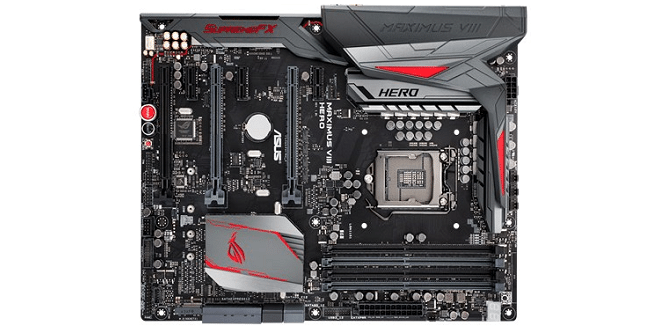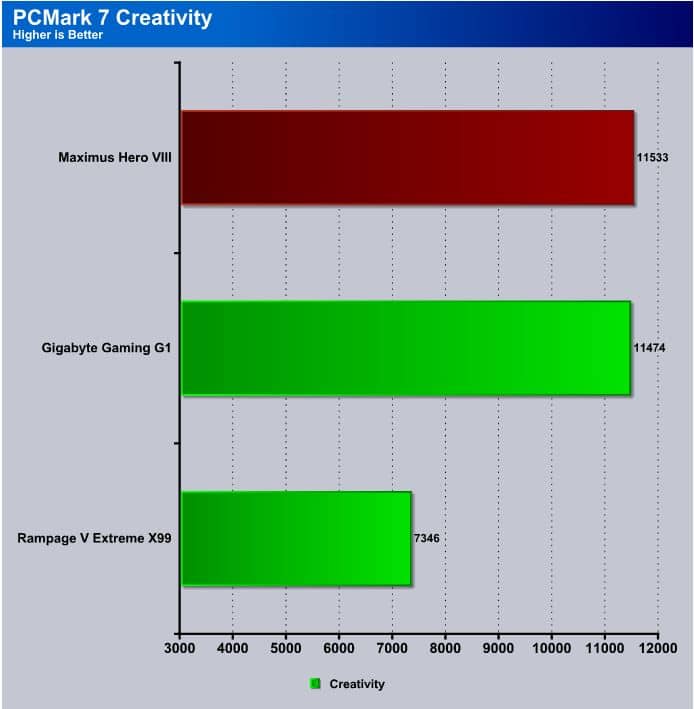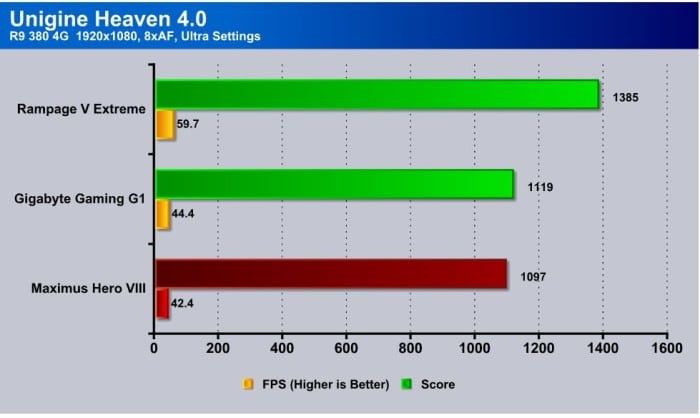Benchmarks
PCMark Creativity shows the Asus Maximus VIII Hero on top the chart the Gigabyte Gaming G1 is right behind it and obviously the benchmark favors raw speed over numbers of cores because the Rampage V Extreme with the 5820K lagged far behind at its native frequency of 3,3GHz.
The Asus Maximus VIII Hero gave us a score of 7263 in the PCMark Entertainment category and landed less than a hundred points behind the more expensive GIgabyte Gaming G1.which is Gigabytes Flagship board so we aren’t even sure if it’s proper to compare the Hero to the Gaming G1 but they bot sport the same Intel chipset and most boards differentiate themselves with features these days and performance tends to be similar.
Here again PCMark’s overall score sees less than a hundred points between the two Z170 boards and again the 4.2GHz i7 6700k leverages its speed to best the 5820k.
The productivity suite in PCMark sees the Asus Maximus VIII Hero 37 points behind the Gigabyte Gaming G1 and considering the price difference the Hero is doing well against the flagship Gaming G1.
Super PI Mod 1.9
Super PI is a single-threaded benchmark that calculates Pi to a specific number of digits. It uses the Gauss-Legendre algorithm and is a Windows port of a program used by Yasumasa Kanada in 1995 to compute Pi to 232 digits.
SuperPi is a single Thread application that we use to compare single core efficiency and how the motherboard handles single core and memory operations. The Asus Maximus VIII Hero ran a couple of seconds behind the Gigabyte board but truthfully with Windows 10 sprouting it’s uglier side the difference might be attributed to something as small as a Windows service running because it saw 7 unused threads.
The 1M SuperPi run shows the Maximus Hero about 0.156 behind the Gaming G1 and both the SkyLake boards put a sound whipping on the X99 5820K.
wPrime
wPrime is a leading multithreaded benchmark for x86 processors that tests your processor performance by calculating square roots with a recursive call of Newton’s method for estimating functions, with f(x)=x2-k, where k is the number we’re sqrting, until Sgn(f(x)/f'(x)) does not equal that of the previous iteration, starting with an estimation of k/2. It then uses an iterative calling of the estimation method a set amount of times to increase the accuracy of the results. It then confirms that n(k)2=k to ensure the calculation was correct. It repeats this for all numbers from 1 to the requested maximum.
On Wprime we ran both stock speed and a 4.7GHz OC test and on the 32M test we see the Hero running at 0.143 seconds slower. Step up to the 1024M test and the HEro ran a couple of seconds behind the Gaming G1. Like we mentioned earlier it’s a flagship board and a non-flgship so we would expect the flagship to perform a little better but the question we all have to answer is about price. Is the small differences we are seeing here worth the extra cash for a flagship board? Sure the luxury of a flagship is appealing but not to our bank accounts. The Hero series has always been a good value money/performance wise.
CINEBENCH R15
CINEBENCH is a real-world cross-platform test suite that evaluates your computer’s performance capabilities. CINEBENCH is based on MAXON’s award-winning animation software CINEMA 4D, which is used extensively by studios and production houses worldwide for 3D content creation. MAXON software has been used in blockbuster movies such as Iron Man 3, Oblivion, Life of Pi or Prometheus and many more.

The Maximus VIII HEro came out ahead on Cinebench but the differences are so small if it were a horse race it’d be a photo finish.
x264 HD
Simply put, x264 HD Benchmark is a reproducible measure of fast your machine can encode a short HD quality video clip into a high quality x264 video file. It’s nice because everyone running it will use the same video clip and software.
X264HD shows the Hero Board around .5 seconds behind the Gaming G1 on the 1 pass test, swap to the 2 pass test and the HEro is less than 2 seconds behind.
Unigine Heaven 4.0
Heaven Benchmark, with its current version 4.0, is a GPU-intensive benchmark that hammers graphics cards to the limits. This powerful tool can be effectively used to determine the stability of a GPU under extremely stressful conditions, as well as check the cooling system’s potential under maximum heat output. It provides completely unbiased results and generates true in-game rendering workloads across all platforms
Unigine Heaven favored the X99 Motherboard so it must be well threaded the two Z170 chipset boards placed behind the Intel HEDP. The Gaming G1 came in a few FPS ahead and the scores were 22 points apart so it’s a tight race there with no clearly defined winner.
Handbrake
We used a 900K Big Buck Bunny video and trans-coded it from AVI to MP4 three times, we added up those 3 runs and averaged the scores reported here.
Here is a detailed breakdown of HandBrake’s features:
Built-in Device Presets—Get started with HandBrake in seconds by choosing a profile optimized for your device, or choose a universal profile for standard or high quality conversions. Simple, easy, fast. For those that want more choice, tweak many basic and advanced options to improve your encodes.
- Supported Input Sources—Handbrake can process most common multimedia files and any DVD or Blu-ray sources that do not contain any kind of copy protection.

Video encoding is normally heavily threaded to deal with the high volumes of data passing through the motherboard, CPU and Ram yes here we see the speed of the Maximus and the i7 6700K running heck and neck with the HEx Core I7 5820K.
ROG RealBench
RealBench uses real, open source applications to test your PC as it would perform in RL. Although it can be competitive, it’s not primarily designed to be more hardcore and time-consuming – it’s a benchmark for everyone.
Select the three tests and run the benchmark to get your result. Each test uses different parts of your PC subsystem, so all areas are covered. Share the result here on the forum to compare to others, or, compare to pre/post overclocks and pre/post upgrades to get maximum value from your PC.

ROG RealBench has turned out to scale well with Memory, CPU’s and Motherboards and it does a darn fine job of stability testing both CPU and Memory OC’s and all it shows is about a 1 second difference between the Hero and the Gaming G1.
The Heavy Multitasking portion or RealBench shows over a 2 second difference between the two Z107 boards but this early in the Z170 game that small a difference has to be called a tie because small score deviations can be drivers or BIOS that need to be tweaked.
RealBench Image Encoding sees the Asus Maximus Hero 2 seconds behind the Gaming G1 and so far all the benchmarks have been neck and neck.
OpenCL the Asus Maximus takes the lead and scores about 130 points higher than the Gigabyte Gaming G1.
SiSoft Sandra
Designed as a complex utility for analyzing your computer’s software and hardware abilities as well as running various tests to stress out components separately, SiSoftware Sandra Lite is one of the most resourceful apps in its category. It includes numerous options that require significant time to get used to if you’re not familiarized with this kind of software. Suffice it to say, it targets power PC users.
When it comes to hardware data, it is possible to get a complete overview on the computer (e.g. processors, memory, graphics), storage adapters and devices (e.g. drive geometry, S.M.A.R.T.), mainboard, chipsets, busses, processors, power management, display and video adapters, GP (General Purpose) processors and accelerators, printers and faxes, and so on. Regarding software, the application shows details pertaining to the logical drives, file types, fonts, media devices, operating system, memory usage, processes, modules, services and drives, and more.
There are multiple types of benchmarks available, such as SIMD processor units, ALU and FPU processors, as well as financial analysis. Any tasks that you frequently perform can be added to a favorites list for quick access, while information from any area can be generated into a report and exported to file for close inspection and safekeeping. Modules that you don’t need can be easily deactivated. In addition, it is possible to monitor the environment of your computer.

SS Cryptogrophy shows us that we are back to a fraction of a GB difference between the two Z170 boards, in this case 0.08 GB/s.
Cache Memory Latency is measured in Nano Seconds and each Nano second is 1 / 1,000,000,000th of a second so the difference in the two boards here is 5 /10,000,000,000 of a single second.
The Processor Arithmetic test in SS showsthe Gigabyte Gaming G1 slightly ahead both at stock and OC’d speeds.
Processor MultiMedia in Sisoft again shows a couple of boards that for all intents and purposes might as well be twin brothers when it comes to performance.
Memory bandwidth shows us that the Gaming G1 is 0.72GB/s ahead of the Asus Maximus VIII Hero.
TrueCrypt
TrueCrypt is a discontinued source-available freeware utility used for on-the-fly encryption (OTFE). It can create a virtual encrypted disk within a file or encrypt a partition or (under Microsoft Windows except Windows 8 with GPT) the entire storage device (pre-boot authentication).

TrueCrypt is about to fall off our benchmarks as it doesn’t seem to show granular enough measurements to give us any differences in tests, it measures to one decible place and similar boards usually end up tied like we see here.
Metro 2033
In 2013, a nuclear war occurred, forcing a large amount of Moscow’s surviving population to relocate to underground metro stations in search of refuge from the outside world. Eventually, those who settled in the underground train stations evolved their homes into independent station-countries. Soon, new factions grew, ranging from the independent “Rangers” to the communist “Red Line” faction to the “Fourth Reich” which constantly engages in skirmishes with the former group. As these small states began to evolve, the Red Line and the Fourth Reich entered a permanent state of war, as both sought to control the metro and its resources. As the war raged, those stations who refused to join either side were massacred by the militants, raided by bandits, or outright destroyed by the Dark Ones – paranormal, otherworldly, mutated humans who live on the ravaged surface. While most of the stations are controlled by the three factions, several stations are abandoned, some have independent tribal rule, while some are occupied by the Dark Ones. Within one of those stations is where the events of Metro 2033 unfold.
Gaming is one of the things driving the desktop industry and is always a concern to serious gaming enthusiasts. We used the XfX R9 380 4G to test all the boards and top to bottom we see a very small difference in FPS so Z170 looks to be a pretty good gaming platform.
 Bjorn3D.com Bjorn3d.com – Satisfying Your Daily Tech Cravings Since 1996
Bjorn3D.com Bjorn3d.com – Satisfying Your Daily Tech Cravings Since 1996



































